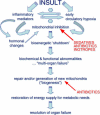Treating critical illness: the importance of first doing no harm
- PMID: 15971943
- PMCID: PMC1160576
- DOI: 10.1371/journal.pmed.0020167
Treating critical illness: the importance of first doing no harm
Abstract
Singer and Glynne present evidence to suggest that the short- term benefits of many interventions for treating critical illness may camouflage an underlying tendency to cause harm.
Conflict of interest statement
Figures

References
-
- Lewis M. The social history of the navy 1793–1815. Mechanicsburg (Pennsylvania): Stackpole Books; 2004. 467 pp.
-
- Beatty W. List of wounded at Battle of Trafalgar. 1805 Available: http://www.nationalarchives.gov.uk/pathways/battles/trafalgar/ts13a.htm. Accessed 22 April 2005.
-
- Barrett CRB. The 13th at Waterloo. 1911 Available: http://www.pinetreeweb.com/waterloo.htm. Accessed 22 April 2005.
-
- United States Civil War Center. Statistical summary of America's major wars. 2001 Available: http://www.cwc.lsu.edu/cwc/other/stats/warcost.htm. Accessed 22 April 2005.
-
- Adams GW. Doctors in blue: The medical history of the Union Army in the Civil War. Baton Rouge (Louisiana): Louisiana State University Press; 1996. 253 pp.
Publication types
MeSH terms
LinkOut - more resources
Full Text Sources
Medical

